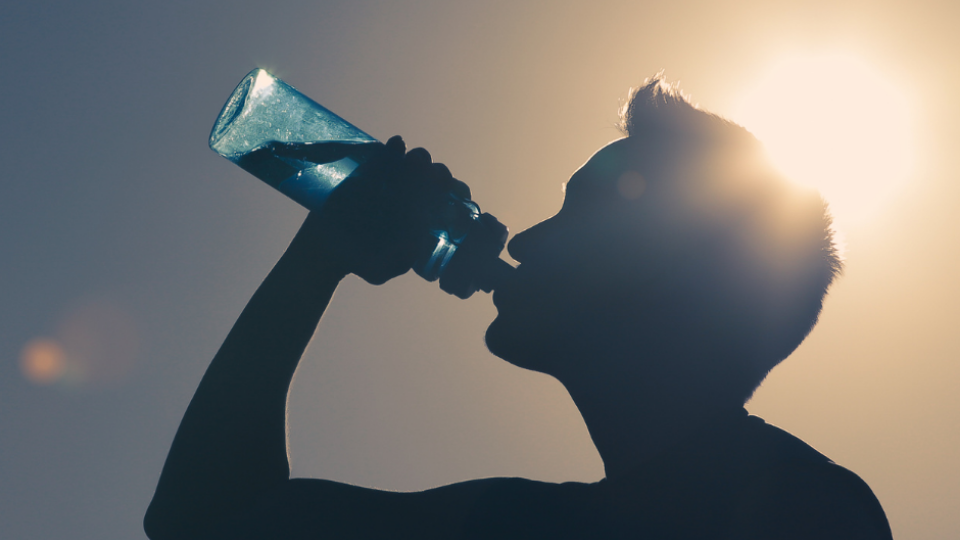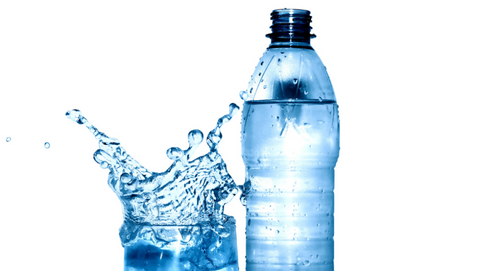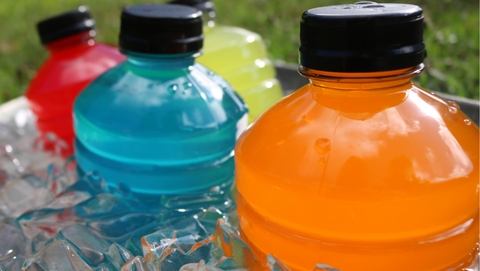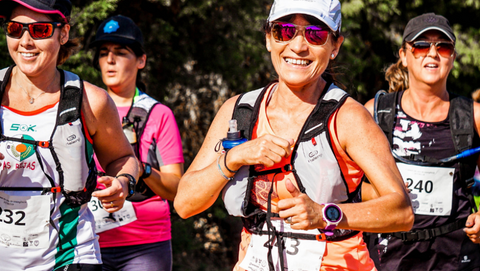Maintaining Hydration: A Guide for Endurance Runners

Being well hydrated is essential to a runner’s health and endurance performance. Hydration is the act of replacing bodily fluids that are lost, so our bodies can continue to function correctly. Adequate hydration involves not only getting enough fluid but achieving a proper balance of electrolytes within our bodies. Endurance runners place additional stress on their bodies through training and competition. Because of this, fluid and electrolyte needs are increased to maintain vital bodily processes while supporting optimal endurance performance. This article will cover topics including:
- roles of fluid and electrolytes in relation to endurance performance
- factors affecting fluid-electrolyte balance
- risks of fluid-electrolyte imbalances
- recommendations for intake
- strategies to achieve optimal hydration
Fluid and Endurance Performance

Water plays a central role in maintaining many of the body’s proper functions. Important functions include temperature regulation, joint lubrication, digestion, and waste elimination. While hydration is important for everyone, runners must make fluid intake a priority to remain healthy and strong through endurance exercise. This can best be explained by understanding the consequences of running on the body.
When running, you demand your body to work harder. Your major muscle groups contract, your heart pumps faster, and your lungs exchange air at a higher rate. This increase in work creates heat and raises your body temperature. When the body’s internal temperature increases, it begins to sweat in order to regulate its temperature. This rise in body temperature during running results in significant fluid losses through elevated rates of sweating and breathing. If the fluid is not replaced in a timely manner, runners can easily overheat – ultimately compromising endurance performance and increasing the risk of experiencing serious health issues. In fact, research has shown that as little as a 2% loss in fluids among endurance runners during exercise (which is a loss of roughly 3 pounds in a 150-pound runner) can have these adverse effects. While 3 pounds of weight loss seems unlikely, the average amount of fluid lost during 1 hour of running is 3 pounds without any fluid consumption. Thus, fluid intake during exercise must be adequate, so runners do not experience declines in endurance performance. On the other hand, runners are also at risk of overhydrating in efforts to compensate for fluid losses, which too can have severe health consequences. To prevent health issues and promote optimal performance, endurance runners must strive to remain well hydrated throughout training, competition, and recovery.
Electrolytes and Endurance Performance
Electrolytes are minerals that are often characterized by their ability to carry an electric charge when dissolved in water. Located in the body’s fluid and cells, electrolytes are key contributors in many essential bodily functions including:

- conducting nerve impulses
- contracting muscles
- regulating blood pH
- maintaining fluid balance
Electrolyte levels must be balanced in order for the body to work correctly. The key electrolytes in the body are sodium, magnesium, potassium, calcium, and chloride. If the body experiences any deficiency of the key electrolytes, it can impair endurance performance and eventually result in negative health outcomes.
Endurance runners are at an increased risk of experiencing electrolyte imbalances due to electrolyte losses from sweating. This can be made worse if individuals rehydrate solely with water, further depleting their electrolyte levels. Common signs of low electrolyte levels that occur during running include muscle cramping and side stitches. If electrolytes are not replaced, the effects can become more severe. With this in mind, it is essential that endurance runners prioritize electrolytes alongside fluid intake to achieve optimal hydration during training, competition, and recovery. Specific recommendations and tips on how to do so will be discussed in the following sections of this article.
Factors Affecting Fluid-Electrolyte Balance
There are several factors that affect a runner’s fluid and electrolyte balance. For example, the amount of sweat lost during exercise will play a role in determining the amount of fluid and electrolytes that are needed to replenish the body. For individuals who are heavy sweaters, more fluid and electrolytes (especially sodium) will be necessary to support endurance performance and overall health compared to individuals who are less prone to sweating. Details on how to calculate fluid loss and adjust accordingly are provided later in this article.
Climate also affects fluid and electrolyte balance. In general, running in hot climates, regardless of whether they are dry or humid, will increase fluid and electrolyte needs. This is because runners lose additional fluids and electrolytes through increases in sweating caused by hot environments. Thus, drinking more fluid assists with better temperature regulation and endurance performance in hot climates. Surprisingly, fluid and electrolyte needs are also increased when running in cold, dry climates. This is because breathing increases, allowing additional fluids to be lost through respiration. Sweat rates can also increase in cold, dry environments as the heat created from exercise becomes trapped within a runner’s warm clothing. These are important considerations to remember when making a hydration plan.
Altitude is another factor to consider when striving to remain well-hydrated. Research has shown that runners become dehydrated more quickly when running at higher altitudes. This is because the rate of breathing increases due to less oxygen availability at higher elevations. Remember to keep the altitudes of your training and competition environments in mind when assessing your fluid and electrolyte needs.
Finally, a runner’s level of fitness may also influence their hydration status. In general, new runners that are not used to intense exercise often experience lower rates of sweating, but higher rates of breathing during exercise than trained runners. Because these factors affect fluid and electrolyte balance in opposite directions, it is essential that runners calculate fluid losses after exercise to determine their exact needs.
Risks of Fluid-Electrolyte Imbalances
Fluid-electrolyte imbalances can be associated with a variety of health conditions, but the two main issues facing runners are dehydration and overhydration.
Dehydration is a condition of losing more fluid than is taken in. It is common among endurance runners due to frequent, vigorous, and long bouts of exercise. In the early stages of dehydration, there are no major health risks. However, mild dehydration can have negative impacts on endurance performance by slowing a runner’s pace and decreasing coordination. Mild dehydration can be identified by being able to recognize these common symptoms:
- Thirst
- Fatigue
- Dry mouth
- Dark-colored urine
- Dizziness
- Headache
- Muscle cramping
If dehydration progresses to moderate and severe stages, symptoms often escalate to nausea, confusion, and even lethargy. At the point of severe dehydration, organ damage or even death could occur. It is vital that runners stay ahead of dehydration – not only to achieve optimal performance, but to prevent the development of serious health risks.
Overhydration, known as hyponatremia, is often caused by drinking too much water. It is a serious condition that occurs when the body’s sodium levels are too low. The resulting fluid-electrolyte imbalance can cause headaches, confusion, nausea, and fatigue in mild cases or quickly progress to seizures, coma, or even death in severe cases.
Because endurance runners have higher fluid needs than the average person, this group is also at higher risk of experiencing hyponatremia through well-intentioned efforts to remain hydrated. With this in mind, it is imperative that runners balance their water intake with sources of electrolytes as well. Keep reading to find out how this can be accomplished.
Fluid and Electrolyte Recommendations for Endurance Runners

Determining fluid and electrolyte needs as an endurance runner can be challenging because there are a variety of conflicting recommendations. With this in mind, Tables 1, 2, and 3 provide the current evidence-based fluid and electrolyte recommendations for before, during, and after endurance exercise. It is recommended that you use these guidelines as a starting point to create a personalized hydration plan. Keep in mind that many factors influence a runner’s fluid and electrolyte needs including body size, sweat loss, running climate, running altitude, and level of fitness.
As you create a personalized hydration plan, pay attention to your body’s responses, and fine-tune your approach accordingly. This will ultimately result in a hydration regimen that allows you to feel and perform your best.
Table 1. Fluid and electrolyte recommendations before exercise
|
Fluid Recommendation |
Electrolyte Recommendation |
|---|---|
|
Two to four hours before exercise, runners should drink 0.07 to 0.14 ounces (oz) of fluid for each pound (lb) of body weight. You should be comfortably full when you begin exercise.
If you tend to be a heavy sweater or are exercising in a hot climate, your needs may be closer to 0.14 oz of fluid per lb of body weight. However, if you are going for a shorter run or do not sweat as much, you can drink closer to 0.7 oz per lb of body weight. You can always adjust the amount you drink before your next run if you find that you need more or less.
If you are doing a morning run and do not have time to hydrate 2 to 4 hours before exercise, drink at least 6 to 8 oz of water when you wake up. It is also important that you remain well-hydrated the day before your morning run.
Example: A 150 lb individual should drink between 10.5 to 21 oz of fluid, 2 to 4 hours before exercise. To convert this to cups, divide the number of oz by 8 (8 oz = 1 cup). This is roughly 1 1/3 to 2 2/3 cups of water for a 150 lb individual. |
Most pre-exercise hydration should come directly from water. If you would like to consume a sports drink with carbohydrates and electrolytes, do so within an hour of exercise. |
Table 2. Fluid and electrolyte recommendations during exercise
|
Fluid Recommendation |
Electrolyte Recommendation |
|---|---|
|
Drink 4 to 6 oz of fluid every 15 minutes throughout exercise.
As a good rule of thumb, one big gulp is about 1 oz of fluid. |
If you are exercising for less than an hour, electrolyte supplementation is not necessary.
If you are exercising for more than an hour, supplement with electrolytes. Products with both electrolytes and carbohydrates will be most advantageous to performance. You can choose a sports drink, electrolyte powder, gels, or gummies. Salty foods such as pretzels and crackers can be a good option too.
If you are a heavy sweater or are exercising in a hot climate, make sure your electrolyte source is rich in sodium. Individuals in this category should consume roughly 300-600 milligrams of sodium per hour during prolonged exercise. |
Table 3. Fluid and electrolyte recommendations after exercise
|
Fluid Recommendation |
Electrolyte Recommendation |
|---|---|
|
To assess fluid loss, weigh yourself before and after exercise. Any change in weight is reflective of a change in fluid status.
For every lb of weight lost, rehydrate with 16 to 24 oz of fluid. If you have gained weight, this is an indicator that you are overhydrating during exercise. |
Electrolyte replacement after exercise is dependent upon the amount of fluid lost during exercise. If you find that you have to replace a lot of fluid to maintain your pre-exercise weight, add an electrolyte beverage in alongside your water to avoid hyponatremia.
Your post-exercise meal can also contribute towards meeting your electrolyte needs. Because sodium is the main electrolyte lost through sweating, prioritize salty foods after exercise. Consuming a balanced diet of whole grains, dairy products, fruits, vegetables, and nuts/seeds will help replenish the rest of your electrolytes. |
These recommendations apply to all running durations – whether you are completing a short or long run. However, if you are planning to run a shorter distance (3 miles or less) and do not want to carry fluids during your run, just make sure that you hydrate before your run and replenish your fluid and electrolyte stores after your run by following the guidelines provided in Tables 1 and 3.
Strategies to Achieve Optimal Hydration
While the formal fluid and electrolyte guidelines provide runners with valuable technical information, it can still be difficult to implement and personalize these concepts in practice. Here are some strategies to assist you in achieving optimal hydration throughout endurance exercise:
- Practice! If you want to perform your best during competition, you need to practice your hydration plan in training. Try different electrolyte products, and practice drinking enough fluid before and during your run. If you find you are unable to drink enough fluid during exercise and notice symptoms of dehydration, practice increasing the amount of fluid you drink each time you run. You can train your stomach to tolerate more fluid as you go. This can be by as little as drinking an extra ounce (1 big gulp) of fluid during each hour of your run until you reach your hydration goal. Adjust your plan as needed depending on your body’s responses.
- Find a way to carry fluid with you while you run. Choose a backpack, vest, belt, or any other method that allows you to hydrate while exercising. Get used to using this tool in training.
- If you are preparing for a long run, drop off a bottle of water or sports drink along the route you will run, so you do not have to carry all of your fluid at once. You can leave it in a bush or behind a rock, so nobody takes it. You can also plan a route that passes by a water fountain, so you can stop for a refill.
- Alternate between drinking water and an electrolyte-containing beverage while running. This will help maintain your fluid-electrolyte balance during exercise.
- If you find it difficult to drink while running, take the time to slow to a walk and rehydrate. Walking will make drinking much easier. You will lose more time from becoming dehydrated than you will to take quick hydration breaks.
- Rotate using the electrolyte products that you like, so you do not get sick of them. If you only like a single product, try rotating flavors to provide more variety.
- Do not waste water by pouring it on your body! Our bodies cool most efficiently from the inside out. If you begin to overheat, drink up.
- You still need to hydrate when running in the cold. Because our bodies do not become as thirsty in cooler climates, you may have to drink according to schedule rather than thirst. Set a timer on your watch if you need the reminder to hydrate.
- Pay attention to the color of your urine as an indicator of hydration status. When adequately hydrated, your urine should be pale yellow – similar to the color of lemonade. If your urine is clear, you are likely drinking too much. If it is dark, resembling the color of apple juice, you need to drink more.
References
- American Lung Association (2022, November 17). Exercise and Lung Health. https://www.lung.org/lung-health-diseases/wellness/exercise-and-lung- health#:~:text=As%20your%20physical%20fitness%20improves,breath%20during%20exercise%20over%20time.
- Armstrong, L. E. (2021). Rehydration during Endurance Exercise: Challenges, Research, Options, Methods. Nutrients, 13(3), 887. https://doi.org/10.3390/nu13030887
- Centers for Disease Control and Prevention. (2022, June 6). Water and Healthier Drinks. https://www.cdc.gov/healthyweight/healthy_eating/water-and-healthier- drinks.html#:~:text=Water%20helps%20your%20body%3A,%2C%20perspiration%2C%20and%20bowel%20movements.
- Clevland Clinic. (2021, September 24). Electrolytes. https://my.clevelandclinic.org/health/diagnostics/21790-electrolytes
- Cleveland Clinic. (2023, June 5). Dehydration. https://my.clevelandclinic.org/health/treatments/9013-dehydration
- James, L. J., Funnell, M. P., James, R. M., & Mears, S. A. (2019). Does Hypohydration Really Impair Endurance Performance? Methodological Considerations for Interpreting Hydration Research. Sports medicine, 49(2), 103–114. https://doi.org/10.1007/s40279-019-01188-5
- Karpinski, C., & Rosenbloom, C. A. (Eds.). (2017). Rosenbloom CA. Sports nutrition: A Handbook for Professionals. (6th ed.). Academy of Nutrition and Dietetics.
- Klingert, M., Nikolaidis, P. T., Weiss, K., Thuany, M., Chlíbková, D., & Knechtle, B. (2022). Exercise- Associated Hyponatremia in Marathon Runners. Journal of Clinical Medicine, 11(22), 6775. https://doi.org/10.3390/jcm11226775
- Liska, D., Mah, E., Brisbois, T., Barrios, P. L., Baker, L. B., & Spriet, L. L. (2019). Narrative Review of Hydration and Selected Health Outcomes in the General Population. Nutrients, 11(1), 70. https://doi.org/10.3390/nu11010070
- Mayo Clinic. (2022, May 17). Hyponatremia. https://www.mayoclinic.org/diseases-conditions/hyponatremia/symptoms-causes/syc-20373711
- Stellingwerff, T., Peeling, P., Garvican-Lewis, L. A., Hall, R., Koivisto, A. E., Heikura, I. A., & Burke, L. M. (2019). Nutrition and Altitude: Strategies to Enhance Adaptation, Improve Performance and Maintain Health: A Narrative Review. Sports medicine, 49(2), 169–184. https://doi.org/10.1007/s40279-019-01159-w
- Surapongchai, J., Saengsirisuwan, V., Rollo, I., Randell, R. K., Nithitsuttibuta, K., Sainiyom, P., Leow, C. H. W., & Lee, J. K. W. (2021). Hydration Status, Fluid Intake, Sweat Rate, and Sweat Sodium Concentration in Recreational Tropical Native Runners. Nutrients, 13(4), 1374. https://doi.org/10.3390/nu13041374
- Thomas, D. T., Erdman, K. A., & Burke, L. M. (2016). Position of the Academy of Nutrition and Dietetics, Dietitians of Canada, and the American College of Sports Medicine: Nutrition and Athletic Performance. Journal of the Academy of Nutrition and Dietetics, 116(3), 501-528. https://doi.org/10.1016/j.jand.2015.12.006
- Titchenal, A. C. (n.d.). Hydration Basics for Endurance Runners. Faerber’s Flyers. http://www.hawaii.edu/run/hydrate.htm#:~:text=Typical%20sweat%20loss%20during 20running,this%20and%20some%20lose%20less.
Authors
Madison Gunter, RD, Master of Public Health StudentJenna Dyckman, RD, MS, Extension Assistant Professor

Madison Gunter


